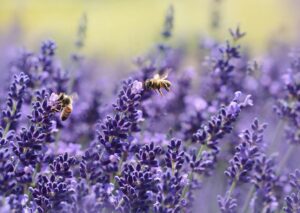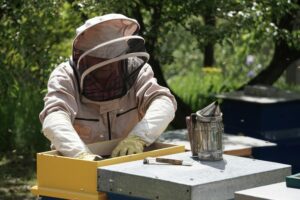The 3 main types of beekeeping include: hobbyist, commercial, and urban beekeeping. Each type has distinct characteristics, goals, and practices.

Table of Contents
Types of Beekeeping
Hobbyist Beekeeping
- Definition: Hobbyist beekeeping is the one of the types of beekeeping practiced on a small scale, typically by individuals or families who keep a few hives for personal enjoyment and to produce honey and other bee products for personal use. This is a suitable choice for beginners.
- Goals: The primary goals are personal satisfaction, a connection to nature, and a modest yield of honey and beeswax.
- Personal Satisfaction:
- Hobby and Passion: Many beekeepers find immense joy and fulfillment in caring for their hives, observing bee behavior, and learning about the intricacies of bee life.
- Skill Development: Beekeeping offers the opportunity to develop valuable skills in animal husbandry, problem-solving, and environmental stewardship.
- Community Engagement: Sharing experiences and knowledge with other beekeepers can build a sense of community and support.
- Connection to Nature:
- Environmental Awareness: Beekeeping fosters a deeper understanding of local ecosystems, pollination, and the vital role bees play in agriculture and biodiversity.
- Outdoor Activity: Regular hive inspections and maintenance provide a healthy, outdoor activity that connects beekeepers to the natural world.
- Wildlife Observation: Beekeepers often become more attuned to the behaviors of other pollinators and wildlife, enriching their overall appreciation of nature.
- Modest Yield of Honey and Beeswax:
- Honey Production: Even small-scale beekeeping can yield enough honey for personal use, gifts, or small-scale sales, providing a sweet reward for the beekeeper’s efforts.
- Beeswax Uses: Harvesting beeswax allows for the creation of natural products such as candles, lip balms, and salves, adding to the practical benefits of beekeeping.
- Self-Sufficiency: Producing honey and beeswax contributes to a more self-sufficient lifestyle, reducing reliance on commercial products and supporting sustainable living practices.
- Personal Satisfaction:
- Practices: Hobbyist beekeepers often use traditional methods and may experiment with different hive designs and beekeeping techniques. They usually have more time to devote to each hive and can give individualized attention to their bees.
- Scale: Usually involves 1-10 hives.
- Investment: Lower initial investment compared to commercial beekeeping, with expenses primarily for basic equipment and bee colonies.
Commercial Beekeeping
- Definition: Commercial beekeeping is a large-scale operation focused on maximizing the production of honey, beeswax, and other bee products for sale. It often also involves providing pollination services to agricultural crops.
- Goals: The main goals are profitability, high productivity, and efficiency in managing large numbers of hives.
- Profitability:
- Increase sales through effective marketing strategies.
- Optimize pricing strategies to maximize profit margins.
- Explore new revenue streams such as beekeeping courses or consultancy services.
- High Productivity:
- Source high-quality beekeeping equipment and supplies.
- Implement automation where possible in hive management processes.
- Streamline order fulfillment and inventory management systems.
- Efficiency in Managing Large Numbers of Hives:
- Develop scalable hive management protocols.
- Utilize data analytics for predictive hive health monitoring.
- Train staff or provide resources for beekeepers to handle larger operations effectively.
- Profitability:
- Practices: Commercial beekeepers use advanced techniques and equipment to manage hundreds or thousands of hives. They often migrate hives to different locations to provide pollination services and to optimize honey production based on floral availability.
- Scale: Can involve hundreds to thousands of hives.
- Investment: Requires significant investment in equipment, transportation, and labor. It also demands a deep understanding of bee management and business practices.
- Advanced Techniques in Apiculture: 10 Pro Tips for Beekeepers
Urban Beekeeping
- Definition: Urban beekeeping is practiced in cities and suburban areas. It focuses on integrating beekeeping into urban environments, often with an emphasis on sustainability and local food production.
- Goals: Goals include contributing to local food systems, enhancing urban biodiversity, and educating the public about the importance of bees.
- Contributing to Local Food Systems:
- Promote local honey production and consumption.
- Support local farmers and beekeepers through partnerships or supply chains.
- Advocate for sustainable beekeeping practices that benefit local agriculture.
- Enhancing Urban Biodiversity:
- Encourage rooftop and urban beekeeping initiatives.
- Promote the planting of bee-friendly flora in urban areas.
- Collaborate with urban planners and communities to create bee-friendly habitats.
- Educating the Public about Bee Importance:
- Develop educational resources on beekeeping and pollination.
- Organize workshops, webinars, or community events on bee conservation.
- Partner with schools, environmental groups, and local governments to raise awareness.
- Contributing to Local Food Systems:
- Practices: Urban beekeepers need to be mindful of their neighbors and local regulations. They often use smaller, more portable hives and employ techniques to minimize disturbances to the surrounding community. Rooftop gardens, backyards, and community gardens are common locations for urban hives.
- Scale: Typically involves a small number of hives, similar to hobbyist beekeeping.
- Investment: Moderate investment in portable and discreet beekeeping equipment. Urban beekeepers may also need to invest in additional measures for hive security and neighbor relations.
- Discover more here.
Each type of beekeeping serves different purposes and operates on different scales, but all contribute to the health and sustainability of bee populations and the environment.



